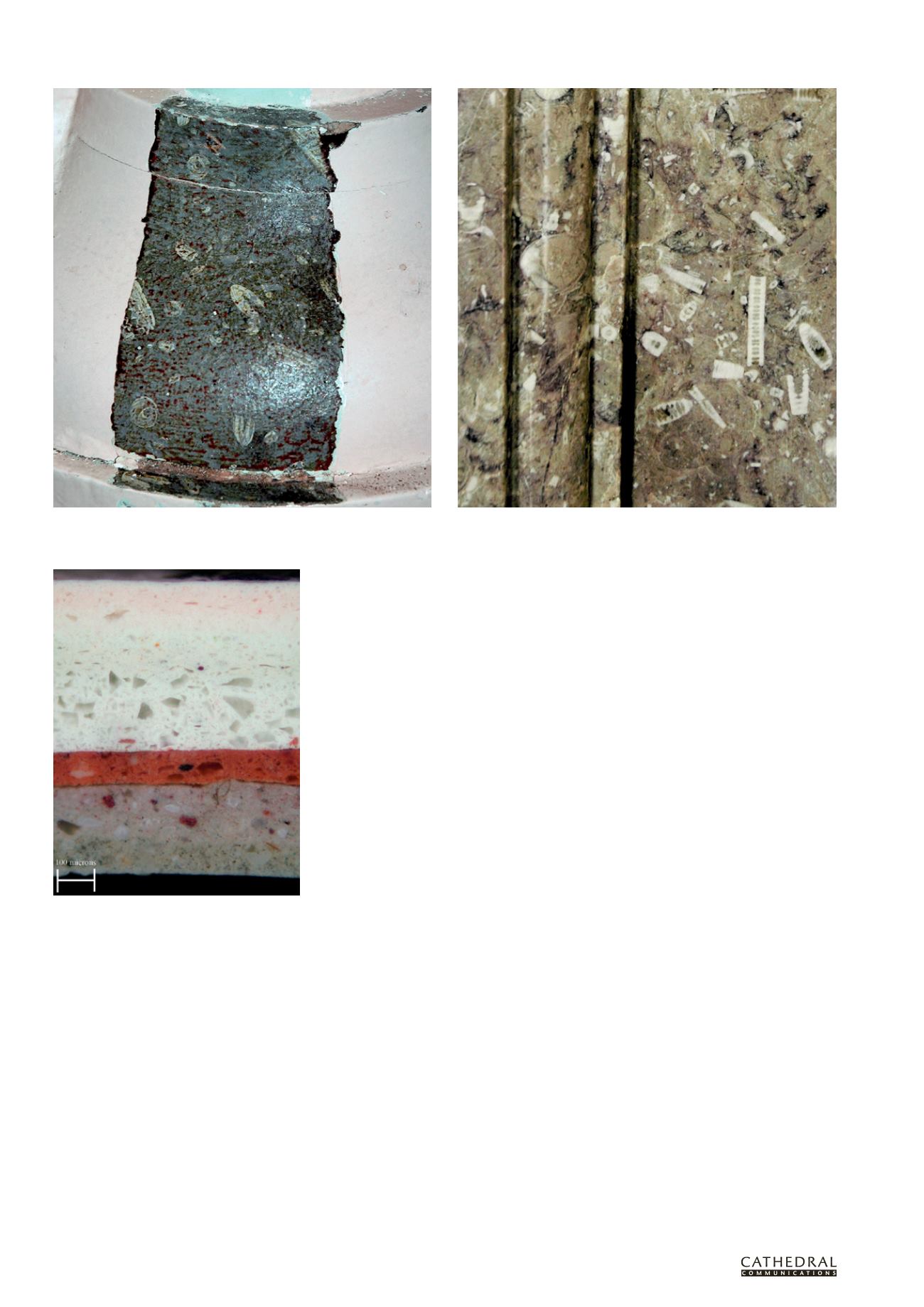

1 6 8
T H E B U I L D I N G C O N S E R VAT I O N D I R E C T O R Y 2 0 1 5
T W E N T Y S E C O N D E D I T I O N
INTER IORS
5
CONSERVATION
Many examples of Victorian marbling
survive in historic buildings, but this does
not detract from its significance. Many of
these examples are in reasonable condition
and can simply be maintained and cared for
using preventive conservation measures.
However, as with all architectural painting,
faux marbling is part of the building
structure and is especially vulnerable to
moisture both as a fluid (entering through
leaking roofs for example) and from cycles
of changing relative humidity (caused by
fluctuations in visitor numbers for example).
At a low level it is often subject to abrasion
through everyday use, and occasionally
damage occurs due to well-intended but
ultimately destructive routine cleaning.
Advice from qualified conservators is
essential if any conservation or redecoration
is being considered. Interventive treatments
such as conservation cleaning to remove
discoloured coatings need to be considered
carefully given the multi-layered composite
nature of the technique. The application of
highly diluted glazing results in thin layers
which are vulnerable to solvents and cleaning
agents. Original protective varnish layers
may have been re-worked so that part of the
design may overlay the varnish.
The use of organic pigments can result
in irreversible fading upon exposure to
ultraviolet light. In contrast, the use of
linseed oil as a paint medium can result
in darkening and yellowing of the paint in
areas with poor natural light. Original or
later applications of resin varnishes will
have a tendency to darken over time but
attempts to remove them may jeopardise
the thinly applied glazing layers below.
An understanding and acceptance that
marbling will almost inevitably have altered
in appearance with time should underpin its
preservation. However, marbling was often
waxed after completion and a light cleaning
and re-waxing can achieve good results.
If there has been damage and loss to
areas of marbling, highly skilled decorator/
conservators can recreate the design.
Law restricts the use of certain historic
pigments, such as lead white but obsolete
or unobtainable pigments can be replaced
with substitutes. Where marbling has been
damaged this can be coloured in, or where
larger sections have been lost these may be
worked into blending old with new, using
intervention layers like synthetic varnish to
separate the original and the repair.
Recommended Reading
H Binns,
‘
A History of the British Decorators
’
Association
’
, British Decorators
’
Association, 1994
I Bristow,
Architectural Colour in British
Interiors 1615-1840
, Yale University Press,
London, 1996
J Fleming and T Taylor,
The Life and Times of
Ernest Dobson, Grainer, Marbler, Decorative
Painter
, Fleming & Taylor, Clitheroe, 2006
A Roy and P Smith (eds),
International
Institute for Conservation 1994 Ottawa
Congress: Preventive Conservation
–
Practice, Theory and Research
, Archetype
Publications, London, 1994
AR Van der Burg and P Van der Burg,
School
of Painting for the Imitation of Woods and
Marbles
etc
’
, London, The Technical Press
Ltd, 7th edition, 1936
FRANCIS STACEY
is director of the
Wiltshire based company FE Stacey & Co
(see
page 163)
which specialises in restoration
and decoration in listed and period
properties, carrying on the traditions of old
paint and plaster techniques such as wood
graining, marbling and lime plastering.
JANE DAVIES
trained as a painting
conservator, specialising in paint analysis,
and worked for English Heritage in the wall
painting conservation and architectural
paint research sections prior to setting up
Jane Davies Conservation in 1996 to provide
expert paint analysis services.
Castle Howard, Long Gallery,
c
1811: uncovering trial following paint sampling,
revealed painted marbling on a pilaster skirting, which was intended to match
the fossil marble of the mantelpiece.
Detail of the fossil marble mantelpiece in the Long Gallery
Paint sample from the imitation marbling. The paint
sample was prepared in cross-section, polished and
photographed under dark-field reflected light at 200x
magnification. The upper white and pink surface
layer date from the 20th century. The orange red
layer is from the late 19th century when the room
was wallpapered. The thin translucent dark layer is
varnish, over pink grey on a grey ground.
















